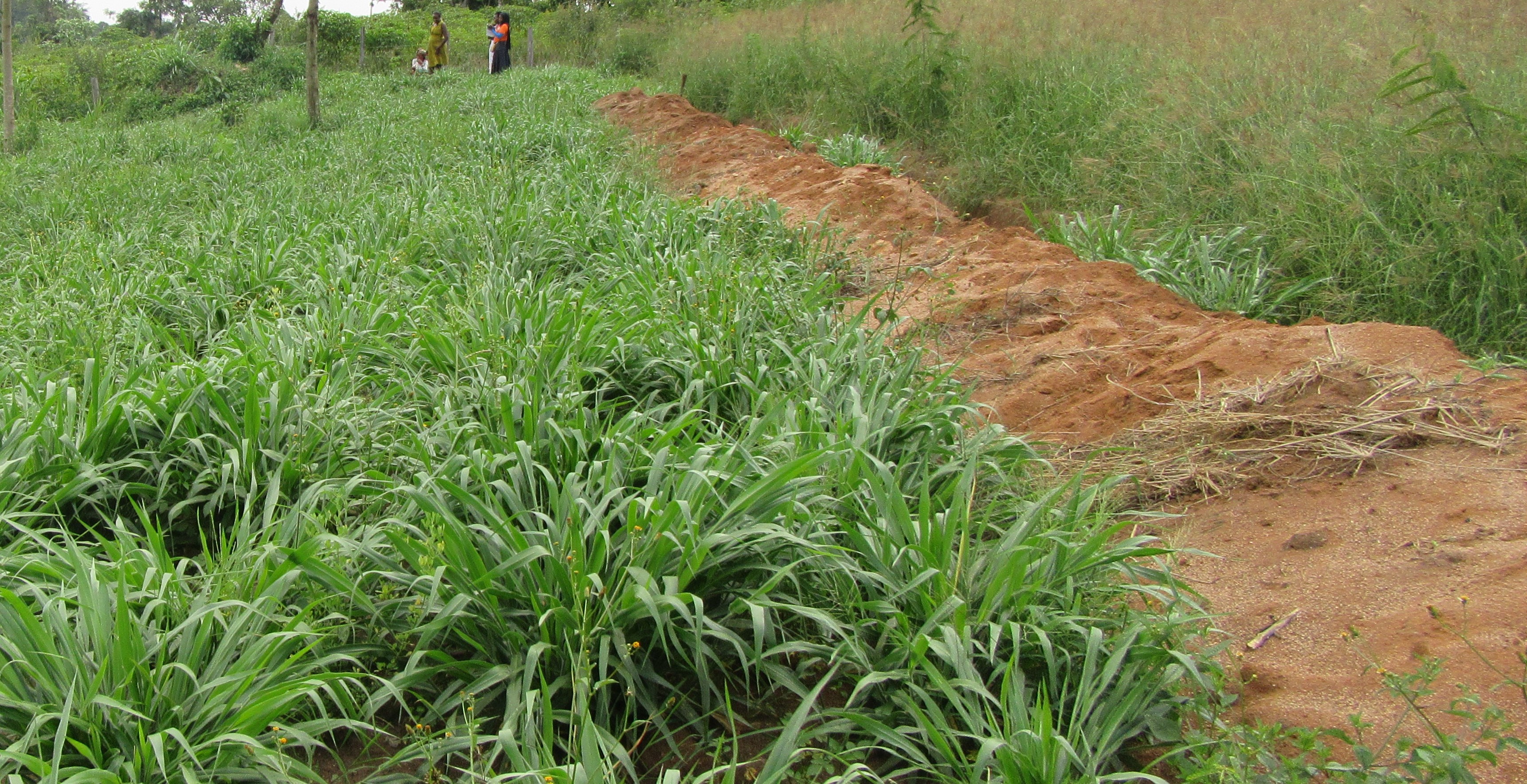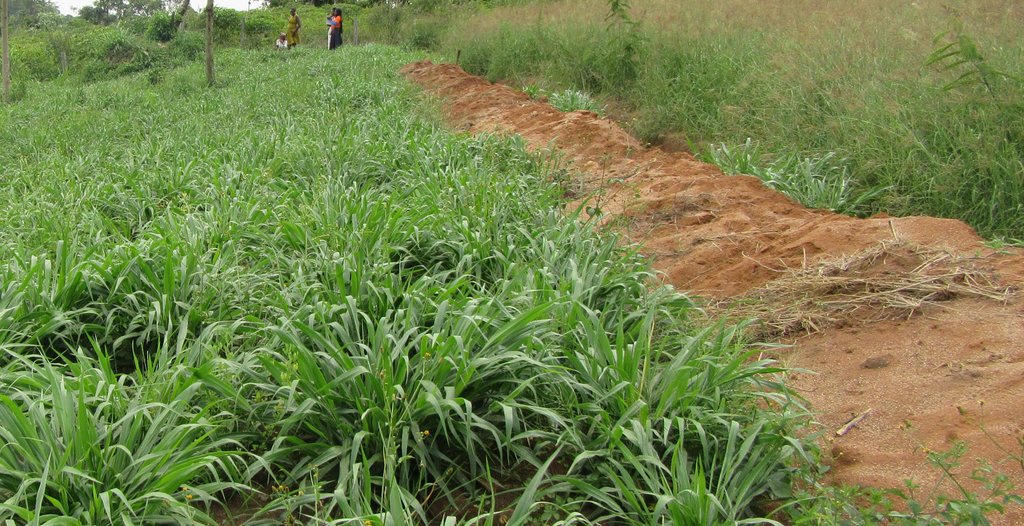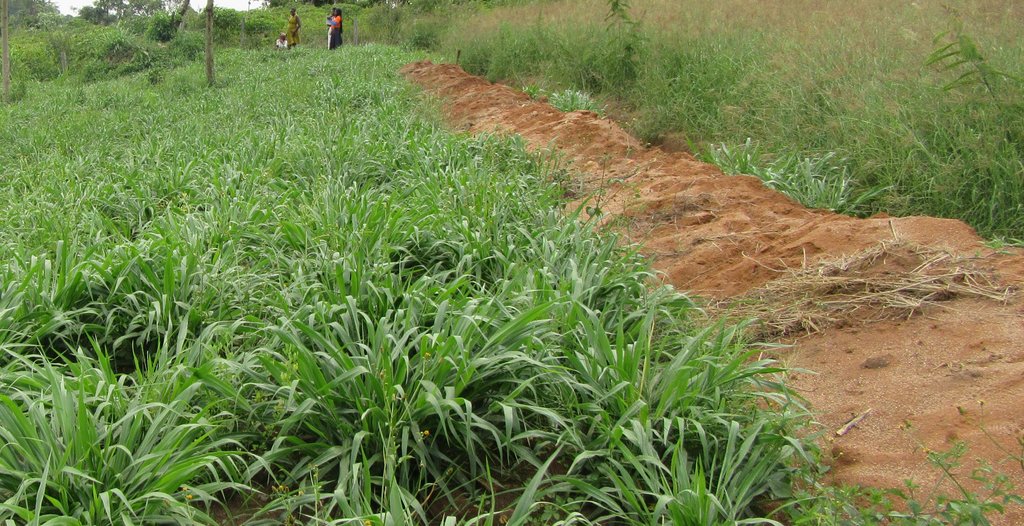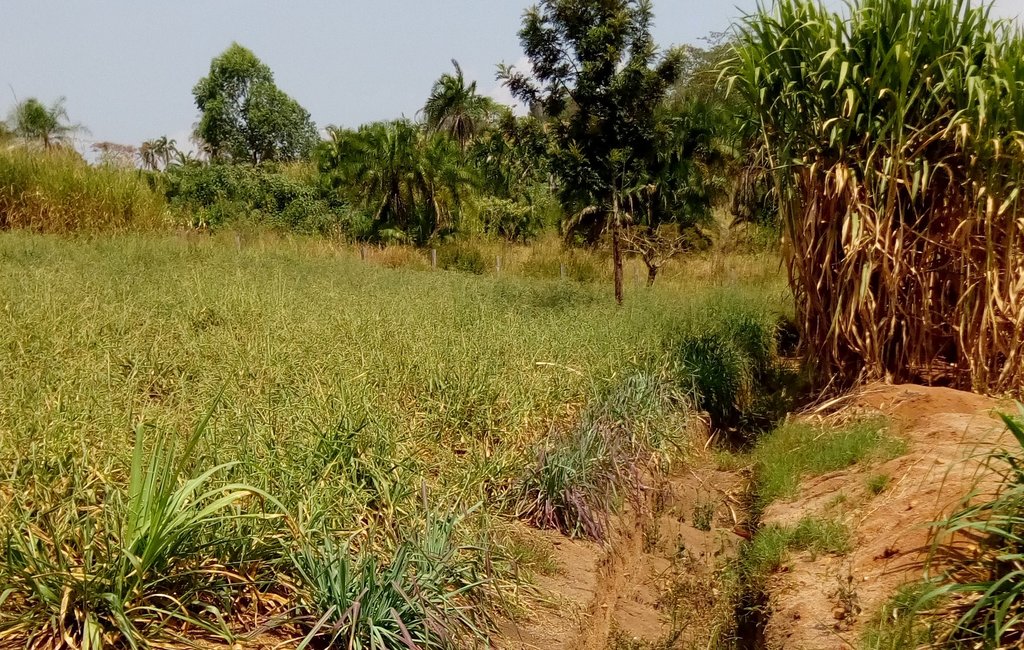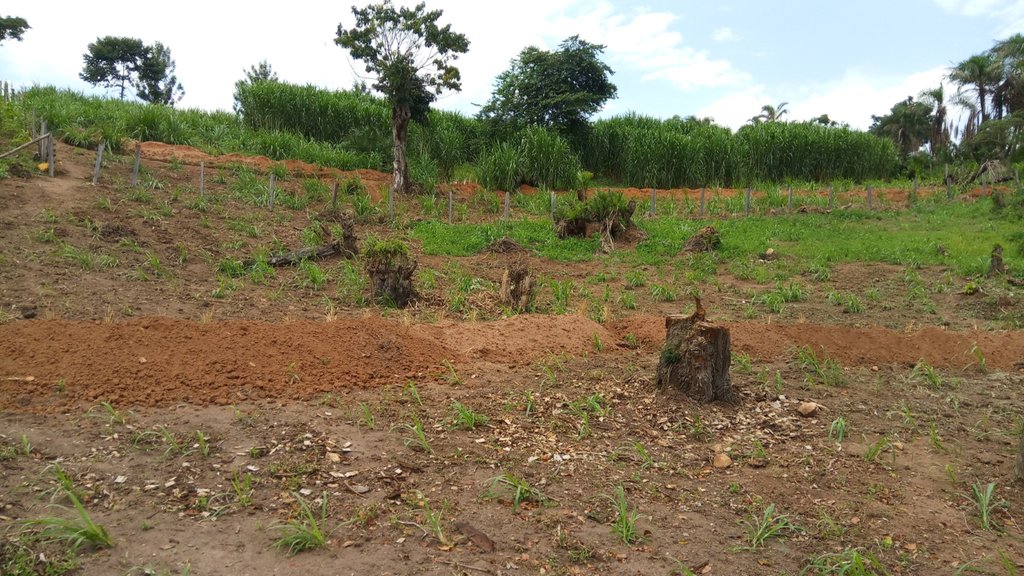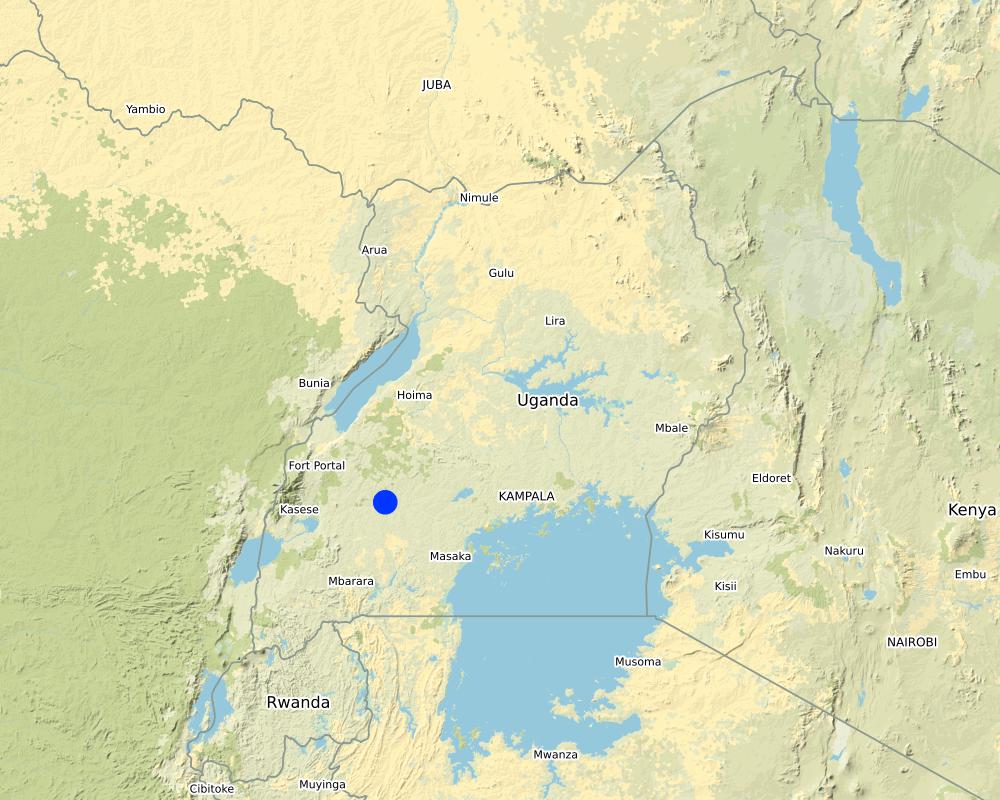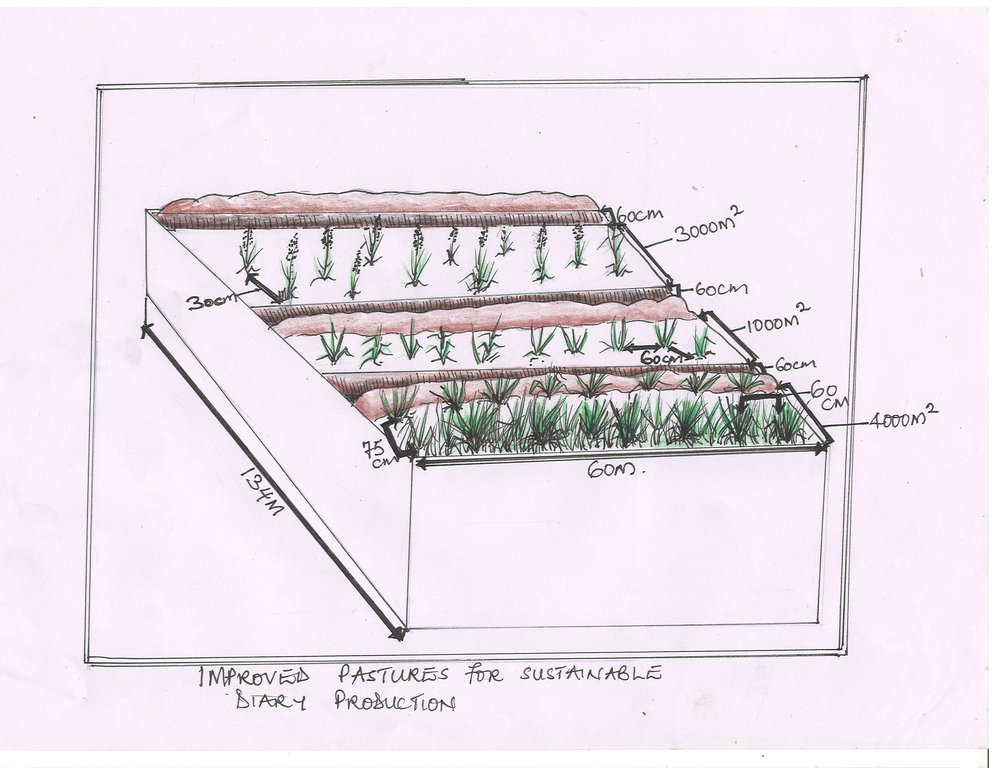Growing Improved Pastures for Sustainable Dairy Production [Uganda]
- Creation:
- Update:
- Compiler: Jalia Namakula
- Editor: Kamugisha Rick Nelson
- Reviewers: Nicole Harari, Udo Höggel
Ebinyansi byokurisa ente zamate
technologies_3362 - Uganda
View sections
Expand all Collapse all1. General information
1.2 Contact details of resource persons and institutions involved in the assessment and documentation of the Technology
Key resource person(s)
land user:
Mugisha Robert
Diary for Life
Kyegeggwa District
Uganda
Name of project which facilitated the documentation/ evaluation of the Technology (if relevant)
Scaling-up SLM practices by smallholder farmers (IFAD)Name of the institution(s) which facilitated the documentation/ evaluation of the Technology (if relevant)
National Agricultural Research Organisation (NARO) - Uganda1.3 Conditions regarding the use of data documented through WOCAT
When were the data compiled (in the field)?
17/10/2018
The compiler and key resource person(s) accept the conditions regarding the use of data documented through WOCAT:
Ja
1.4 Declaration on sustainability of the described Technology
Is the Technology described here problematic with regard to land degradation, so that it cannot be declared a sustainable land management technology?
Nee
Comments:
Pastures act as fallows therefore they improve soil quality over time
2. Description of the SLM Technology
2.1 Short description of the Technology
Definition of the Technology:
Growing Improved Pastures (chloris gayana, brachiaria mulato and pernisetum purpurem) is a technology promoted among small, meduim scale farmers in Kyegegwa District, Western Uganda for sustainable dairy production, improved nutrition and sustainable land management.
2.2 Detailed description of the Technology
Description:
Improved pastures comprising of fast growing nutritious grasses or legumes are generally said to be more productive than the local native pastures, because they have higher protein, carbohydrate levels and are easy to digest.
The pastures on the farm documented are established on a 2 acre piece of land located on a gently sloping area of about 20% in Kyegegwa District which experiences an average annual rainfall of about 1200 mm. The field covers the entire landscape and is neighboured by a cassava plantation. Within the same field, contour trenches were established to separate one pasture field from the other, and to also prevent soil and nutrient loss within the field. Pastures planted include Chloris gayana (rhodes grass), Brachiaria mulato (signal grass) and Pennisetum (napier grass). All grasses are native to East Africa.
Each pasture type on each plot is planted as a pure stand; the Chloris field lies on a 3000 m2 plot size, the Brachiaria field lies on 1000 m2 plot size and the Pennisetum field lies on a 4000 m2 plot size.
-Chloris gayana was planted at a spacing of 30 cm inter row and broadcasted within the rows, the seeds were mixed with sand before they were broadcasted. Thereafter the seeds were covered lightly with soils to enable easy germination of the tiny seeds.
-Brachiaria mulato was planted at a spacing of 60X 60cm
-Napier was planted at 75x 60cm.
Prior to establishment of the pastures, the plots were cleared of the bush, ploughed twice and harrowed to make a fine seed bed before planting. Two tonnes of animal manure was added. The following equipment was used:
-Hand hoes
-3 slashers
-A spirit level for leveling the contour trenches
Planting material for all the grasses was provided by the Rwebitaba Zonal Agricultural Research and Development Institute (RwebiZARDI) in form of root tillers for Brachiaria, seeds for Chloris and cuttings for the Pennisetum grass.
Kyegegwa is one of the districts where conflicts between livestock keepers and crop farmers are increasing. This kind of pressure does not allow free range grazing any more. Therefore the pastures planted were not only to provide better quality and quantity feeds for the dairy project throughout the year but also to reduce on conflicts with neighbours. Chloris gayana yields between 20-27t DM/ha and was planted to provide hay. It is drought tolerant, has a high regeneration capacity, easy to digest and is rich in carbohydrates, while Bracharia mulato is also palatable and often used in a cut & carry system. Bracharia is easy to conserve as compared to other grasses and is rich in proteins. Napier grass was planted for its early maturity, regeneration capacity, especially during the rainy season and just like Brachiaria easy to makes silage. The improved pastures are suitable for both cut & carry and grazing and they are tolerant to drought therefore providing a sustainable feed base for the diary all year round. The pastures were also planted to act as a fallow, thereby also improving soil fertility.
Establishment costs were estimated to be at UGX 1,396,000 while maintenance costs were estimated to be at UGX 320,000 per annum. Improved pastures are advantageous because they provide more nutrients than local pastures; Chloris provides more carbohydrates whereas Brachiaria and Penisetum provide more protein. Pastures rehabilitate degraded land by acting as vegetation cover for longer periods hence reducing soil erosion and increasing soil fertility. They control broad leaved weeds and a small piece of land is used to cut and carry for stock. Improved pastures require fencing as well as improved management practices such as a good soil fertility plan.
2.3 Photos of the Technology
2.4 Videos of the Technology
Comments, short description:
Video showing improved pastures
Date:
17/10/2017
Location:
Kamwenge District, South Western Uganda
Name of videographer:
Jalia Namakula
2.5 Country/ region/ locations where the Technology has been applied and which are covered by this assessment
Country:
Uganda
Region/ State/ Province:
Western Uganda
Further specification of location:
Kamwenge Town Council
Comments:
The practice was established in Kyegegwa town council, Kyegegwa District, Western Uganda.
Map
×2.6 Date of implementation
Indicate year of implementation:
2016
2.7 Introduction of the Technology
Specify how the Technology was introduced:
- through projects/ external interventions
Comments (type of project, etc.):
The improved pastures were promoted by Rwebitaba ZARDI through the Kamwenge District Local government
3. Classification of the SLM Technology
3.1 Main purpose(s) of the Technology
- improve production
- reduce, prevent, restore land degradation
3.2 Current land use type(s) where the Technology is applied

Cropland
- Annual cropping
Main crops (cash and food crops):
Cassava, maize
Comments:
The farm is neighboured by a cassava plantation and a maize field
If land use has changed due to the implementation of the Technology, indicate land use before implementation of the Technology:
The field was previously used for maize cultivation
3.3 Further information about land use
Water supply for the land on which the Technology is applied:
- mixed rainfed-irrigated
Comments:
There is a wetland at the foot of the slopes where water is drawn and used to irrigate the pastures, in addition an irrigation system is being constructed to enable sustainable pasture production.
Number of growing seasons per year:
- 2
Specify:
Pastures are harvested twice a year
3.4 SLM group to which the Technology belongs
- pastoralism and grazing land management
3.5 Spread of the Technology
Specify the spread of the Technology:
- evenly spread over an area
If the Technology is evenly spread over an area, indicate approximate area covered:
- < 0.1 km2 (10 ha)
Comments:
The field lies on 0.8 ha of land
3.6 SLM measures comprising the Technology

vegetative measures
- V2: Grasses and perennial herbaceous plants
Comments:
Improved pastures planted include Signal grass (Brachiaria mulato), Rhodes grass (Chloris gayana), and Napier grass (pernnisetum Purpurem)
3.7 Main types of land degradation addressed by the Technology

soil erosion by water
- Wt: loss of topsoil/ surface erosion

chemical soil deterioration
- Cn: fertility decline and reduced organic matter content (not caused by erosion)

biological degradation
- Bc: reduction of vegetation cover
- Bl: loss of soil life
Comments:
The pastures are a perennial crop that act as a soil cover for longer periods of time, preventing soil and nutrient loss therefore improving soil fertility and productivity
3.8 Prevention, reduction, or restoration of land degradation
Specify the goal of the Technology with regard to land degradation:
- prevent land degradation
- restore/ rehabilitate severely degraded land
Comments:
Pastures, because of their longivity, reduce soil erosion and therefore improve soil fertility
4. Technical specifications, implementation activities, inputs, and costs
4.1 Technical drawing of the Technology
4.2 Technical specifications/ explanations of technical drawing
The technical drawing shows improved pastures established on 0.8 ha of land (8000 m2), planted with Brachiaria (planted on 1000 m2 plot size at a spacing of 60×60cm), Chloris guyana, planted on a 3000 m2 plot size at a spacing of 30cm inter row and seed broadcasted within the row. Napier grass planted on a 4000 m2 plot size at a spacing of 75×60cm, using plant cuttings. The pastures are planted in three different blocks with each block separated by a contour trench of 2 m width and 60 m length. The Brachiaria grows up to a height of 50 cm, Chloris to around 90 cm and Napier grass can grow up to a 2 m.
4.3 General information regarding the calculation of inputs and costs
Specify how costs and inputs were calculated:
- per Technology area
Indicate size and area unit:
2 acres
other/ national currency (specify):
UGX
Indicate exchange rate from USD to local currency (if relevant): 1 USD =:
3800.0
Indicate average wage cost of hired labour per day:
7000
4.4 Establishment activities
| Activity | Type of measure | Timing | |
|---|---|---|---|
| 1. | Slashing | Management | Once |
| 2. | Ploughing | Agronomic | Once |
| 3. | Field Marking | Agronomic | Once |
| 4. | Planting | Agronomic | Once |
4.5 Costs and inputs needed for establishment
| Specify input | Unit | Quantity | Costs per Unit | Total costs per input | % of costs borne by land users | |
|---|---|---|---|---|---|---|
| Labour | Slashing | day | 3.0 | 100000.0 | 300000.0 | 100.0 |
| Labour | Ploughing | day | 3.0 | 120000.0 | 360000.0 | 100.0 |
| Labour | Planting | day | 2.0 | 100000.0 | 200000.0 | 100.0 |
| Labour | Excavating contour trenches | meter | 10000.0 | 100.0 | ||
| Equipment | Slasher | piece | 3.0 | 7000.0 | 21000.0 | 100.0 |
| Equipment | Hoes | piece | 3.0 | 10000.0 | 30000.0 | 100.0 |
| Equipment | Chisel | piece | 1.0 | 10000.0 | 10000.0 | 100.0 |
| Equipment | Spirit level | piece | 1.0 | 20000.0 | 20000.0 | 100.0 |
| Plant material | Wheelbarrow | piece | 1.0 | 75000.0 | 75000.0 | 100.0 |
| Plant material | Panga | piece | 3.0 | 10000.0 | 30000.0 | 100.0 |
| Plant material | Brachiaria | bags | 5.0 | 50000.0 | 250000.0 | |
| Plant material | Chloris gayana | kg | 1.0 | 100000.0 | 100000.0 | |
| Plant material | Napier grass | piece | 10.0 | 50000.0 | 500000.0 | |
| Fertilizers and biocides | Manure | bag | 20.0 | 10000.0 | 200000.0 | 100.0 |
| Total costs for establishment of the Technology | 2096000.0 | |||||
If land user bore less than 100% of costs, indicate who covered the remaining costs:
Labour and equipment costs were covered by the land user
Comments:
Planting material was provided by the Town Council
4.6 Maintenance/ recurrent activities
| Activity | Type of measure | Timing/ frequency | |
|---|---|---|---|
| 1. | Weeding | Agronomic | once a month |
| 2. | Pesticide application | Agronomic | once a month |
| 3. | Cutting | Management | twice a month |
| 4. | Fertiliser application | Agronomic | twice annually |
4.7 Costs and inputs needed for maintenance/ recurrent activities (per year)
| Specify input | Unit | Quantity | Costs per Unit | Total costs per input | % of costs borne by land users | |
|---|---|---|---|---|---|---|
| Labour | Weeding | piece | 1.5 | 80000.0 | 120000.0 | 100.0 |
| Labour | Spraying | piece | 1.5 | 10000.0 | 15000.0 | 100.0 |
| Labour | Cutting | piece | 1.5 | 10000.0 | 15000.0 | 100.0 |
| Equipment | Panga | piece | 3.0 | 10000.0 | 30000.0 | 100.0 |
| Equipment | Knapsack | piece | 1.0 | 120000.0 | 120000.0 | 100.0 |
| Fertilizers and biocides | Pesticides | liter | 1.0 | 20000.0 | 20000.0 | 100.0 |
| Total costs for maintenance of the Technology | 320000.0 | |||||
If land user bore less than 100% of costs, indicate who covered the remaining costs:
The seed and planting material were given by the RwebitabaZARDI through the Kyegegwa Town Council
Comments:
Establishment of the improved pastures was done in partnership with the RwebiZARDI and Kyegegwa town council. The Agreement was for the development partners to provide seed and the beneficiary to incur establishment and maintenance costs .
4.8 Most important factors affecting the costs
Describe the most determinate factors affecting the costs:
Availability of labour
5. Natural and human environment
5.1 Climate
Annual rainfall
- < 250 mm
- 251-500 mm
- 501-750 mm
- 751-1,000 mm
- 1,001-1,500 mm
- 1,501-2,000 mm
- 2,001-3,000 mm
- 3,001-4,000 mm
- > 4,000 mm
Specify average annual rainfall (if known), in mm:
1200.00
Specifications/ comments on rainfall:
Rainfall onsets in March-June
Second season starts in August- December
Agro-climatic zone
- humid
Uganda has a tropical climate
5.2 Topography
Slopes on average:
- flat (0-2%)
- gentle (3-5%)
- moderate (6-10%)
- rolling (11-15%)
- hilly (16-30%)
- steep (31-60%)
- very steep (>60%)
Landforms:
- plateau/plains
- ridges
- mountain slopes
- hill slopes
- footslopes
- valley floors
Altitudinal zone:
- 0-100 m a.s.l.
- 101-500 m a.s.l.
- 501-1,000 m a.s.l.
- 1,001-1,500 m a.s.l.
- 1,501-2,000 m a.s.l.
- 2,001-2,500 m a.s.l.
- 2,501-3,000 m a.s.l.
- 3,001-4,000 m a.s.l.
- > 4,000 m a.s.l.
5.3 Soils
Soil depth on average:
- very shallow (0-20 cm)
- shallow (21-50 cm)
- moderately deep (51-80 cm)
- deep (81-120 cm)
- very deep (> 120 cm)
Soil texture (topsoil):
- medium (loamy, silty)
Soil texture (> 20 cm below surface):
- medium (loamy, silty)
Topsoil organic matter:
- medium (1-3%)
5.4 Water availability and quality
Ground water table:
< 5 m
Availability of surface water:
good
Water quality (untreated):
for agricultural use only (irrigation)
Is water salinity a problem?
Nee
Is flooding of the area occurring?
Ja
Regularity:
episodically
Comments and further specifications on water quality and quantity:
The water table is high
5.5 Biodiversity
Species diversity:
- low
Habitat diversity:
- low
Comments and further specifications on biodiversity:
The field has only grasses
5.6 Characteristics of land users applying the Technology
Sedentary or nomadic:
- Sedentary
Market orientation of production system:
- mixed (subsistence/ commercial
Off-farm income:
- 10-50% of all income
Relative level of wealth:
- rich
Individuals or groups:
- individual/ household
Level of mechanization:
- mechanized/ motorized
Gender:
- men
Age of land users:
- youth
Indicate other relevant characteristics of the land users:
The farmer owns a general merchandise shop in Kyegegwa town
5.7 Average area of land owned or leased by land users applying the Technology
- < 0.5 ha
- 0.5-1 ha
- 1-2 ha
- 2-5 ha
- 5-15 ha
- 15-50 ha
- 50-100 ha
- 100-500 ha
- 500-1,000 ha
- 1,000-10,000 ha
- > 10,000 ha
Is this considered small-, medium- or large-scale (referring to local context)?
- small-scale
Comments:
He owns 4 acres of land but in Kamwenge District average land holding is 10 acres
5.8 Land ownership, land use rights, and water use rights
Land ownership:
- individual, titled
Land use rights:
- individual
Water use rights:
- individual
Comments:
A personal water reservoir was constructed
5.9 Access to services and infrastructure
health:
- poor
- moderate
- good
education:
- poor
- moderate
- good
technical assistance:
- poor
- moderate
- good
employment (e.g. off-farm):
- poor
- moderate
- good
markets:
- poor
- moderate
- good
energy:
- poor
- moderate
- good
roads and transport:
- poor
- moderate
- good
drinking water and sanitation:
- poor
- moderate
- good
financial services:
- poor
- moderate
- good
6. Impacts and concluding statements
6.1 On-site impacts the Technology has shown
Socio-economic impacts
Production
fodder production
Comments/ specify:
The different pastures are planted for sustainable provision of fodder throughout the year, hence stress for feed during drought period has reduced
fodder quality
Comments/ specify:
The livestock is now feeding on highly nutritious fodder hence milk production has increased throughout the year
Income and costs
farm income
Quantity before SLM:
4,500,000
Quantity after SLM:
7,500,000
Comments/ specify:
Before SLM,the land user was getting 15 litres of milk per day per cow at the peak of production but since increasing fodder production he is getting 25 liters of milk per day per cow (10 fresians) at the peak of production which happens in about 7 weeks into lactation period.
Socio-cultural impacts
food security/ self-sufficiency
Comments/ specify:
The farmer's milk production has increased, he gets enough for commercial and home consumption
conflict mitigation
Comments/ specify:
Because he has his own improved pastures , conflict with the neighbours on cutting their grass has reduced
Ecological impacts
Soil
soil moisture
Comments/ specify:
Pastures act as a soil cover therefore reducing on soil water loss
soil cover
Comments/ specify:
Pastures act as a source of soil cover for stay in field longer if properly maintained
soil loss
Comments/ specify:
Because they cover the soils, soil loss has reduced significantly
6.2 Off-site impacts the Technology has shown
downstream flooding
Comments/ specify:
The incidence of down stream flooding has reduced because the pastures allow water infiltration into the soil
6.3 Exposure and sensitivity of the Technology to gradual climate change and climate-related extremes/ disasters (as perceived by land users)
Gradual climate change
Gradual climate change
| Season | Type of climatic change/ extreme | How does the Technology cope with it? | |
|---|---|---|---|
| annual temperature | increase | very well | |
| annual rainfall | decrease | very well |
Comments:
Since pastures help in soil moisture retention they cope with drought easily
6.4 Cost-benefit analysis
How do the benefits compare with the establishment costs (from land users’ perspective)?
Short-term returns:
slightly positive
Long-term returns:
very positive
How do the benefits compare with the maintenance/ recurrent costs (from land users' perspective)?
Short-term returns:
slightly positive
Long-term returns:
very positive
Comments:
Establishment costs of improved pastures are high, therefore benefits are meager at the beginning, but as they last for more than a year, very positive benefits are acquired
6.5 Adoption of the Technology
- single cases/ experimental
Comments:
For now the field is also used as a multiplication site for seed
6.6 Adaptation
Has the Technology been modified recently to adapt to changing conditions?
Nee
6.7 Strengths/ advantages/ opportunities of the Technology
| Strengths/ advantages/ opportunities in the land user’s view |
|---|
| Napier does not flower hence it ensures constant supply of fodder to live stock throughout the year |
| They are highly nutritious |
| They reduce soil erosion |
| Increase soil fertility |
| Strengths/ advantages/ opportunities in the compiler’s or other key resource person’s view |
|---|
| The grasses are resistant to pests and diseases |
| They take a short time to establish |
| They are tolerant to drought |
| The mixer of Chloris, Brachiaria and Penisetum grasses ensures that the animals have a balanced diet |
6.8 Weaknesses/ disadvantages/ risks of the Technology and ways of overcoming them
| Weaknesses/ disadvantages/ risks in the land user’s view | How can they be overcome? |
|---|---|
| Establishment costs are high | soliciting support from local government |
| Accessibility to seed is difficult | its got through District local government |
| Skills in hay production are still lacking | seek for training from development agents |
| Weaknesses/ disadvantages/ risks in the compiler’s or other key resource person’s view | How can they be overcome? |
|---|---|
| If not properly managed the grasses can flower and loose their nutritive value | harvest grass before flowering |
| If the livestock are grazed before the grasses have well established they can be destroyed | cut and carry until pastures have reached 6 months and above |
7. References and links
7.1 Methods/ sources of information
- field visits, field surveys
1
- interviews with land users
1
7.2 References to available publications
Title, author, year, ISBN:
FROM EXTENSIVE TO SEMI-INTENSIVE LIVESTOCK PRODUCTION SYSTEMS IN THE ALBERTINE RIFT; (RashidMubiru., Teddy Namirimu,Suzan Owino, Louis Kyalingonza, Priscilla Nyadoiand Joel Buyinza ). 2013
Available from where? Costs?
http://www.uws.or.ug/wp-content/themes/UWS/PDFs/LIVESTOCK%20MANAGEMENT%20EXTENSION%20MANNUAL%202013%20UWS-1.pdf
7.3 Links to relevant information which is available online
Title/ description:
FROM EXTENSIVE TO SEMI-INTENSIVE LIVESTOCK PRODUCTION SYSTEMS IN THE ALBERTINE RIFT; (RashidMubiru., Teddy Namirimu,Suzan Owino, Louis Kyalingonza, Priscilla Nyadoiand Joel Buyinza ). 2013
URL:
http://www.uws.or.ug/wp-content/themes/UWS/PDFs/LIVESTOCK%20MANAGEMENT%20EXTENSION%20MANNUAL%202013%20UWS-1.pdf
Title/ description:
For more milk, grow pastures for your cows( New vision news paper; Monday,July 29,2019)
URL:
https://www.newvision.co.ug/new_vision/news/1499385/milk-grow-pastures-cows
Links and modules
Expand all Collapse allLinks
No links
Modules
No modules


